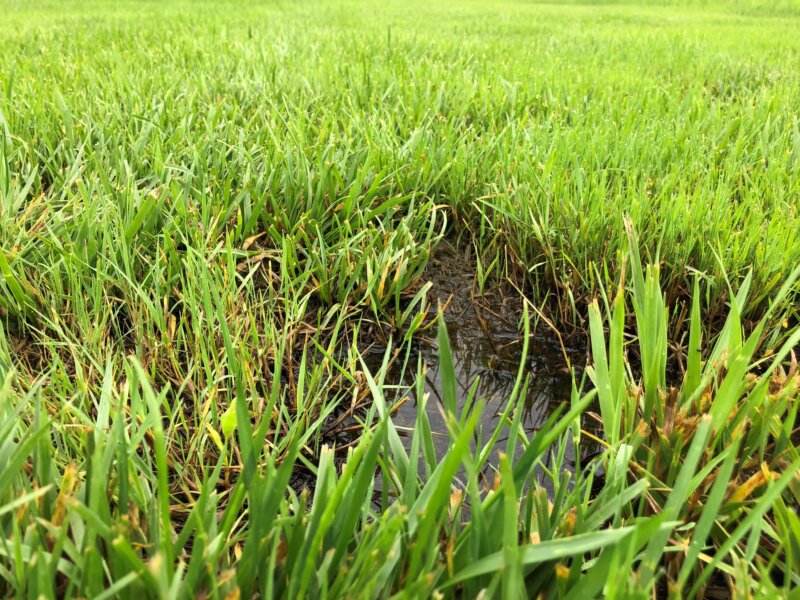Helping lawns recover from rain, after being underwater
Rain-soaked lawns and turf that have been damaged by being underwater for long periods of time, or left covered in silt as flood waters retreat, will need extra TLC in order to recover, according to the University of Vermont Extension community horticulture program.
If your lawn is waterlogged, whether from flooding or heavy rains, the first step is to let it dry out. You may need to make furrows to drain standing water. Or consider using a push-behind or step-on lawn aerator if soils are slow to drain.

Floodwaters and prolonged rains have saturated lawns, like the one pictured here, making mowing and maintenance a challenge.
If possible, avoid extra foot traffic in wet areas and mowing saturated lawns until they’ve had a chance to dry. You want time for the grass to recover without adding soil compaction to already weakened turf. Turf grasses that have been underwater for four or more days may not recover due to prolonged lack of oxygen and light.
Once soils dry out, set your mower to the highest setting possible and make sure blades are sharp. Aim to cut about a third of the grass height per mowing. This will help the plant direct its energy to recovering rather than sending up new growth.
Bring the lawn height down to an optimal three inches. According to the Lawn-to-Lake initiative, maintaining lawns at this height shades out weeds, improves water quality and encourages longer roots for healthier plants and aerated soils.
In addition, you can use an aerator throughout the season to remove small cores of soil and silt. This will allow air and water to reach the roots. Topdress with compost, which will work its way into the holes to fertilize the soil.
Wet conditions also can spur fungal diseases, moss and algae, in addition to weed infestations in lawns. Fungicides are typically not warranted for home lawns, especially if the steps above are put into place to create healthy turf grasses.
Lawns covered with silt from flooding require some extra steps. If covered with less than an inch of silt, break it up by scratching the surface with a steel-toothed rake or similar tool. You can also use a high-pressure garden hose to wash the silt from small sections of your lawn, or at least thin the depth. If the silt dries and crusts, continue to break it up throughout the season until the grass rebounds.
Lawns covered with more than an inch of silt may need to be reestablished from scratch. First, remove as much silt as possible. Silt deposits exceeding three inches will likely need to be removed by a professional.
To renovate lawns with a layer of silt that is less than three inches, till the area, mixing the silt thoroughly with the top four to six inches of original soil. For best results, before reseeding or replanting the area, get your soil tested at the UVM Extension Agricultural and Environmental Testing Lab.
If possible, it is best to wait until late summer to reseed cool-season grasses. Before September or around Labor Day is the optimal window for germination and seedling growth. Tips on lawn renovation and establishment are available on the website.
Another option that works for small areas is to add strips of sod. Just be sure to remove or till in the dead layer of grass before laying new sod.
Budget permitting, refill and replace the topsoil in eroded areas. You can amend any added backfill with organic matter such as compost, rotted wood chips or old mulch.
As you repair your landscape, this might be an opportunity to rethink your lawn. Consider planting a “bee lawn,”. Or rethink your space and instead of a lawn, plant perennials or shrubs, mulching the plantings to help reduce weeds, conserve soil moisture and prevent erosion.
For questions about lawns, contact the University of Vermont Extension master gardener helpline, open 24/7/365 for online questions with an option to submit photos. To talk to a trained extension master gardener, call 802-656-5421 on Thursday mornings between 9 a.m. and noon.
